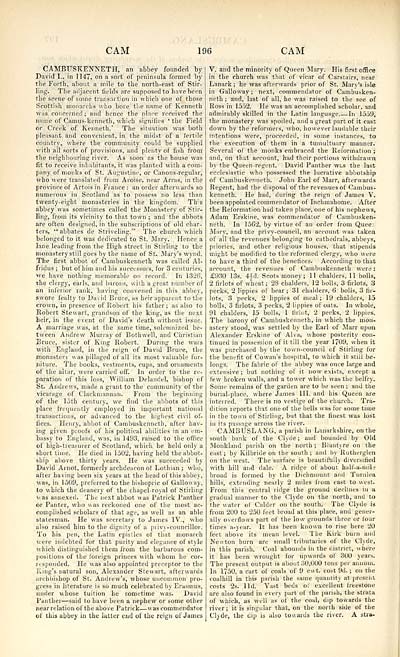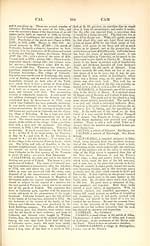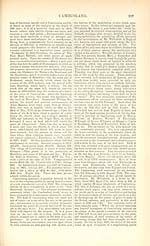Topographical, statistical, and historical gazetteer of Scotland > Volume 1
(276) Page 196
Download files
Complete book:
Individual page:
Thumbnail gallery: Grid view | List view

CAM
196
CAM
CAMBUSKENNETH, an abbey founded by
David I., in 1147, on a sort of peninsula formed by
the Forth, about a mile to the north-east of Stir-
ling-. The adjacent fields are supposed to have been
the scene of some transaction in which one of those
Scottish monarch's who bore the name of Kenneth
was concerned ; and hence the place received the
name of Camus-kenneth, which siprniiics ' the Field
or Creek of Kenneth.' The situation was both
pleasant and convenient, in the midst of a fertile
country, where the community could be supplied
with all sorts of provisions, and plenty of fish from
the neighbouring river. As soon as the house was
tit to receive inhabitants, it was planted with a com-
pany of monks of St. Augustine, or Canons-regular,
who were translated from Aroise, near Arras, in the
province of Artois in France : an order afterwards so
numerous in Scotland as to possess no less than
twenty-eight monasteries in the kingdom. Th's
abbey was sometimes called the Monastery of Stir-
ling, from its vicinity to that town ; and the abbots
are often designed, in the subscriptions of old char-
ters, " ahbates de Striveling." The church which
belonged to it was dedicated to St. Mary. Hence a
lane leading from the High street in Stirling to the
monastery still goes by the name of St. Mary's wynd.
The first abbot of Cambuskenneth was called Al-
fiidus ; but of him and his successors, for 3 centuries,
we have nothing memorable on record. In 1326,
the clergy, earls, and barons, with a great, number of
an inferior rank, having convened in this abhev,
swore fealty to David Bruce, as heir apparent to the
crown, in presence of Robert his father; as also to
Robert Stewart, grandson of the king, as the next
heir, in the event of David's death without issue.
A marriage was, at the same time, solemnized be-
tween Andrew Murray of Bothwell, and Christian
Bruce, sister of King Robert. During the wars
with England, in the reign of David Bruce, the
monastery was pillaged of all its most valuable fur-
niture. The hooks, vestments, cups, and ornaments
of the altar, were carried off. In order to the re-
paration of this loss, William Delanriel, bishop of
St. Andrews, made a grant to the community of the
vicarage of Clackmannan. From the beginning
of the 15th century, we find the abbots of this
place frequently employed in important national
transactions, or advanced to the highest civil of-
fices. Henry, abbot of Cambuskenneth, after hav-
ing given proofs of his political abilities in an em-
bassy to England, was, in 1493, raised to the office
of high-treasurer of Scotland, whicli he held only a
short time. He died in 1502, having held the abbot-
ship above thirty years. He was succeeded by
David Arnot, formerly archdeacon ot Lothian ; who,
after having been six years at the head of this abbey,
was, in 1509, preferred to the bishopric of Galloway,
to which the deanery of the chapel-royal of Stirling
was annexed. The next abbot was Patrick Panther
or Panter, who was reckoned one of the most ac-
complished scholars of that age, as well as an able
statesman. He was secretary to James IV., who
also raised him to the dignity of a piivv-councillor.
To his pen, the Latin epistles of that monarch
were indebted for that purity and elegance of style
which distinguished them from the barbarous com-
positions of the foreign princes with whom he cor-
responded. He was also appointed preceptor to the
King's natural son, Alexander Stewart, afterwards
archbishop of St. Andrew's, whose uncommon pro-
gress in literature is so much celebrated by Erasmus,
under whose tuition he sometime was. David
Panther — said to have been a nephew or some other
near relation of the above Patrick — was commendator
of this abbey in the latter end of the reign of James
V. and the minority of Queen Mary. His first office
in the church was that of vicar of Carstairs, near
Lanark; he was afterwards prior of St. Mary's isle
in Galloway; next, commendator of Cambusken-
neth ; and, last of all, he was raised to the see of
Ross in 1552. He was an accomplished scholar, and
admirably skilled in the Latin language In 1559,
the monastery was spoiled, and a great part of it cast
down by the reformers, who, however laudable their
intentions were, proceeded, in some instances, to
the execution of them in a tumultuary manner.
Several of the monks embraced the Reformation ;
and, on that account, had their portions withdrawn
by the Queen -regent. David Panther wls the last
ecclesiastic who possessed the lucrative abbotship
of Cambuskenneth. John Earl of Marr, afterwards
Regent, had the disposal of the revenues of Cambus-
kenneth. He bad, during the reign of James V.
been appointed commendator of Inchmabome. After
the Reformation had taken place, one of his nepbew r s,
Adam Erskine, was commendator of Cambusken-
neth. In 1562, by virtue of an order from Quee:
Mary, and the privy-council, ati account was taken
of all the revenues belonging to cathedrals, abbeys,
priories, and other religious houses, that stipends
might be modified to the reformed clergy, who were
to have a third of the benefices. According to that
account, the revenues of Cambuskenneth were :
£930 13s. 4id. Scots money; 11 chalders, 11 bolls,
2 firlots of wheat; 2S chalders, 12 bolls, 3 firlots, 3
pecks, 2 lippies of bear ; 31 chalders, 6 bolls, 3 fir-
lots, 3 pecks, 2 lippies of meal; 19 chalders, 15
bolls, 3 firlots, 3 pecks, 2 lippies of oats. In whole,
91 chalders, 15 bolls, 1 firlot, 2 pecks, 2 lippies.
The barony of Cambuskenneth, in which the mon-
astery stood, was settled by the Earl of Marr upon
Alexander Erskine of Alva, whose posterity con-
tinued in possession of it till the year 1709, when it
was purchased by the town-council of Stirling for
the benefit of Cowan's hospital, to which it still be-
longs. The fabric of the abbey was once large and
extensive ; but nothing of it now exists, except a
few broken walls, and a tower which was the belfry.
Some remains of the garden are to be seen ; and the
burial-place, where James III. and his Queen are
interred. There is no vestige of the church. Tra-
dition reports that one of the bells was for some time
in the town of Stirling, but that the finest was lost
in its passage across the river.
CAMBUSLANG, a parish in Lanarkshire, on the
south bank of the Clyde; and bounded by Old
Monkland parish on the north; Blantyre on the
east; by Kilbride on the south; and by Rutherglen
on the west. The surface is beautifully diversified
with hill and dale. A ridge of about half-a-milvj
broad is formed by the Dichmount and Turnlea
hills, extending nearly 2 miles from east to west.
From this central ridge the ground declines in a
gradual manner to the Clyde on the north, and to
the water of Calder on the south. The Clyde is
from 200 to 250 feet broad at this place, and gener-
ally overflows part of the low grounds three or lour
times a-year. It has been known to rise here 20
feet above its mean level. The Kirk burn and
Newton burn are small tributaries of the Clyde,
in this parish. Coal abounds in the district, where
it has been wrought for upwards of 300 years.
The present output is about 30,000 tons per annum.
In 1750, a cart of coals of 9 cut. cost 9d. ; on the
coalhill in this parish the same quantity at present
costs 2s. lid. Vast beds of excellent freestone
are also found in every part of the parish, the strata
of which, as well as of the coal, dip towards the
river; it is singular that, on the north side of the
Cl^de, the dip is also towards the river. A stra-
196
CAM
CAMBUSKENNETH, an abbey founded by
David I., in 1147, on a sort of peninsula formed by
the Forth, about a mile to the north-east of Stir-
ling-. The adjacent fields are supposed to have been
the scene of some transaction in which one of those
Scottish monarch's who bore the name of Kenneth
was concerned ; and hence the place received the
name of Camus-kenneth, which siprniiics ' the Field
or Creek of Kenneth.' The situation was both
pleasant and convenient, in the midst of a fertile
country, where the community could be supplied
with all sorts of provisions, and plenty of fish from
the neighbouring river. As soon as the house was
tit to receive inhabitants, it was planted with a com-
pany of monks of St. Augustine, or Canons-regular,
who were translated from Aroise, near Arras, in the
province of Artois in France : an order afterwards so
numerous in Scotland as to possess no less than
twenty-eight monasteries in the kingdom. Th's
abbey was sometimes called the Monastery of Stir-
ling, from its vicinity to that town ; and the abbots
are often designed, in the subscriptions of old char-
ters, " ahbates de Striveling." The church which
belonged to it was dedicated to St. Mary. Hence a
lane leading from the High street in Stirling to the
monastery still goes by the name of St. Mary's wynd.
The first abbot of Cambuskenneth was called Al-
fiidus ; but of him and his successors, for 3 centuries,
we have nothing memorable on record. In 1326,
the clergy, earls, and barons, with a great, number of
an inferior rank, having convened in this abhev,
swore fealty to David Bruce, as heir apparent to the
crown, in presence of Robert his father; as also to
Robert Stewart, grandson of the king, as the next
heir, in the event of David's death without issue.
A marriage was, at the same time, solemnized be-
tween Andrew Murray of Bothwell, and Christian
Bruce, sister of King Robert. During the wars
with England, in the reign of David Bruce, the
monastery was pillaged of all its most valuable fur-
niture. The hooks, vestments, cups, and ornaments
of the altar, were carried off. In order to the re-
paration of this loss, William Delanriel, bishop of
St. Andrews, made a grant to the community of the
vicarage of Clackmannan. From the beginning
of the 15th century, we find the abbots of this
place frequently employed in important national
transactions, or advanced to the highest civil of-
fices. Henry, abbot of Cambuskenneth, after hav-
ing given proofs of his political abilities in an em-
bassy to England, was, in 1493, raised to the office
of high-treasurer of Scotland, whicli he held only a
short time. He died in 1502, having held the abbot-
ship above thirty years. He was succeeded by
David Arnot, formerly archdeacon ot Lothian ; who,
after having been six years at the head of this abbey,
was, in 1509, preferred to the bishopric of Galloway,
to which the deanery of the chapel-royal of Stirling
was annexed. The next abbot was Patrick Panther
or Panter, who was reckoned one of the most ac-
complished scholars of that age, as well as an able
statesman. He was secretary to James IV., who
also raised him to the dignity of a piivv-councillor.
To his pen, the Latin epistles of that monarch
were indebted for that purity and elegance of style
which distinguished them from the barbarous com-
positions of the foreign princes with whom he cor-
responded. He was also appointed preceptor to the
King's natural son, Alexander Stewart, afterwards
archbishop of St. Andrew's, whose uncommon pro-
gress in literature is so much celebrated by Erasmus,
under whose tuition he sometime was. David
Panther — said to have been a nephew or some other
near relation of the above Patrick — was commendator
of this abbey in the latter end of the reign of James
V. and the minority of Queen Mary. His first office
in the church was that of vicar of Carstairs, near
Lanark; he was afterwards prior of St. Mary's isle
in Galloway; next, commendator of Cambusken-
neth ; and, last of all, he was raised to the see of
Ross in 1552. He was an accomplished scholar, and
admirably skilled in the Latin language In 1559,
the monastery was spoiled, and a great part of it cast
down by the reformers, who, however laudable their
intentions were, proceeded, in some instances, to
the execution of them in a tumultuary manner.
Several of the monks embraced the Reformation ;
and, on that account, had their portions withdrawn
by the Queen -regent. David Panther wls the last
ecclesiastic who possessed the lucrative abbotship
of Cambuskenneth. John Earl of Marr, afterwards
Regent, had the disposal of the revenues of Cambus-
kenneth. He bad, during the reign of James V.
been appointed commendator of Inchmabome. After
the Reformation had taken place, one of his nepbew r s,
Adam Erskine, was commendator of Cambusken-
neth. In 1562, by virtue of an order from Quee:
Mary, and the privy-council, ati account was taken
of all the revenues belonging to cathedrals, abbeys,
priories, and other religious houses, that stipends
might be modified to the reformed clergy, who were
to have a third of the benefices. According to that
account, the revenues of Cambuskenneth were :
£930 13s. 4id. Scots money; 11 chalders, 11 bolls,
2 firlots of wheat; 2S chalders, 12 bolls, 3 firlots, 3
pecks, 2 lippies of bear ; 31 chalders, 6 bolls, 3 fir-
lots, 3 pecks, 2 lippies of meal; 19 chalders, 15
bolls, 3 firlots, 3 pecks, 2 lippies of oats. In whole,
91 chalders, 15 bolls, 1 firlot, 2 pecks, 2 lippies.
The barony of Cambuskenneth, in which the mon-
astery stood, was settled by the Earl of Marr upon
Alexander Erskine of Alva, whose posterity con-
tinued in possession of it till the year 1709, when it
was purchased by the town-council of Stirling for
the benefit of Cowan's hospital, to which it still be-
longs. The fabric of the abbey was once large and
extensive ; but nothing of it now exists, except a
few broken walls, and a tower which was the belfry.
Some remains of the garden are to be seen ; and the
burial-place, where James III. and his Queen are
interred. There is no vestige of the church. Tra-
dition reports that one of the bells was for some time
in the town of Stirling, but that the finest was lost
in its passage across the river.
CAMBUSLANG, a parish in Lanarkshire, on the
south bank of the Clyde; and bounded by Old
Monkland parish on the north; Blantyre on the
east; by Kilbride on the south; and by Rutherglen
on the west. The surface is beautifully diversified
with hill and dale. A ridge of about half-a-milvj
broad is formed by the Dichmount and Turnlea
hills, extending nearly 2 miles from east to west.
From this central ridge the ground declines in a
gradual manner to the Clyde on the north, and to
the water of Calder on the south. The Clyde is
from 200 to 250 feet broad at this place, and gener-
ally overflows part of the low grounds three or lour
times a-year. It has been known to rise here 20
feet above its mean level. The Kirk burn and
Newton burn are small tributaries of the Clyde,
in this parish. Coal abounds in the district, where
it has been wrought for upwards of 300 years.
The present output is about 30,000 tons per annum.
In 1750, a cart of coals of 9 cut. cost 9d. ; on the
coalhill in this parish the same quantity at present
costs 2s. lid. Vast beds of excellent freestone
are also found in every part of the parish, the strata
of which, as well as of the coal, dip towards the
river; it is singular that, on the north side of the
Cl^de, the dip is also towards the river. A stra-
Set display mode to: Large image | Transcription
Images and transcriptions on this page, including medium image downloads, may be used under the Creative Commons Attribution 4.0 International Licence unless otherwise stated. ![]()
| Gazetteers of Scotland, 1803-1901 > Topographical, statistical, and historical gazetteer of Scotland > Volume 1 > (276) Page 196 |
|---|
| Permanent URL | https://digital.nls.uk/97440858 |
|---|
| Description | Volume first. A-H. |
|---|---|
| Attribution and copyright: |
|

